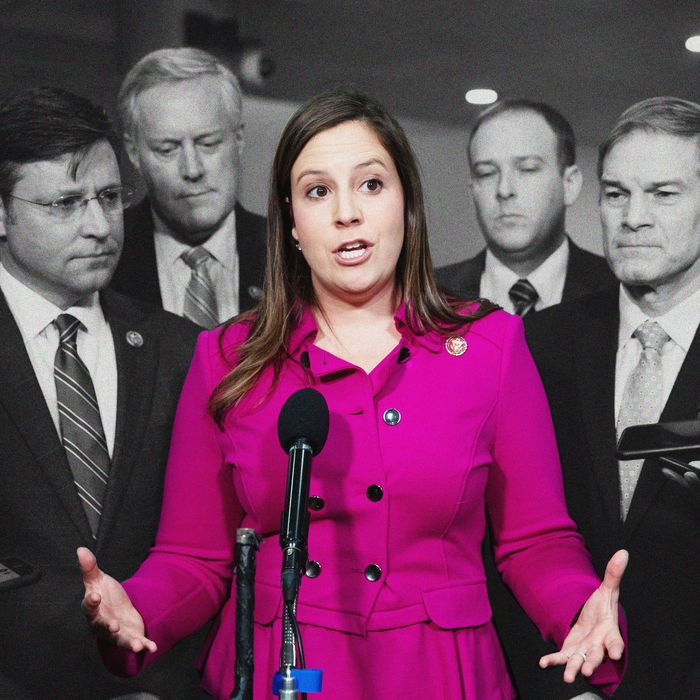
Election Night 2020 was a historic one for women in the House of Representatives. “If you want something said, ask a man. If you want something done, ask a woman,” one incumbent, who won her district by a landslide, tweeted with pride as results came in. “Huge thanks to the women who paved the way!” said a first-timer. A prominent female strategist wrote that candidates’ success proved “we have to communicate that we are not the party of old white men.”
While these sentiments might remind you of the 2018 “pink wave,” in which Democratic women candidates dominated in the House midterms — this time around, they were being expressed by Republicans. The GOP did indeed have a historic Election Night: There will be at least 13 Republican non-incumbent women in the freshman class of the House of Representatives in 2021, surpassing the party’s previous record of nine such candidates in 2010. This brings the total number to 26 — woefully behind Democrats, who will have 88 women in the House in 2021 (down one from 2018), but Republican women — who helped flip at least six seats — are being touted as an emergent force. Donald Trump called this the “Year of Republican Women” in one of his post-election speeches.
Meanwhile, Democrats had a poor showing down-ballot nationwide, suffering a net loss of at least seven seats. Women were supposed to turn out at historic proportions for Democrats, but instead the turnout stayed around the same as it was 2016. “Democrats were spending so much time patting themselves on the back for women winning in 2018,” says Rebecca Katz, founder of New Deal Strategies, a consulting firm that has worked on the campaigns of Cynthia Nixon and several other women on the left, “that they didn’t see Republican women coming in 2020.”
And Republican women came quickly. They invested heavily in running female candidates in the past two years, largely spurred by Elise Stefanik, who became a glass-ceiling-shatterer herself when she won her capital-area New York congressional district in 2014 as a 30-year-old, then the youngest woman to be elected to the House (before AOC). Within months of the Democratic “pink wave,” Stefanik proclaimed that the GOP was “facing a crisis level of Republican women in Congress,” and launched a new PAC to run women in primaries. She faced mild pushback. After one party official called her efforts a “mistake,” Stefanik fired back on Twitter, “NEWSFLASH: I wasn’t asking for permission.” Now she’s positioning herself as a triumphant underdog: “For all these naysayers,” she told Politico after November 3, “we have proven that strong, Republican women are the best candidates to put on the ballot.”
In an uncanny echo of Democrats’ own 2018 rhetoric, there are now GOP groups with blandly feminist-sounding names like VIEW (Value in Electing Women) and “Winning for Women,” fundraising in opposition to blue state predecessors like “Run for Something” and “She the People.” The fact that these platitudes can be so easily co-opted makes them ring ultimately hollow. There is obvious value in electing women in a country where a staggering 75% of both chambers of government that dictate policy are male: Female leadership has been instrumental in attempting to pass paid family leave, in speaking out against family separation, and in raising the alarm about the increasingly conservative Supreme Court. But women are not a monolith, and there’s nothing revolutionary about a woman politician who votes like an old white guy. And many female candidates are anything but progressive: The Republican “pink wave” includes Lauren Boebert, the owner of a gun-themed restaurant who rose to fame by defying Covid shutdown orders, and Marjorie Taylor Greene, a QAnon believer and conspiracy theorist.
Democrats have also been guilty of this incongruity. Take, for example, the party’s candidate in Kentucky, Amy McGrath. McGrath was lavished with fundraising assistance and support from the national Democratic establishment largely because she was seen as a kind of Republican-lite, and thereby someone who could beat Mitch McConnell. The fact that she was a female veteran was ostensibly a combined asset: Her gender gave her an edge, while her moderate views appealed to centrists and moderates. “As a woman in the military,” she tweeted after winning her primary nomination over Charles Booker, a challenger from the left, “I learned quickly that I’d have to fight the establishment to succeed.” But exactly how McGrath planned to “fight,” except by being publicly against Trump, remained in question through her race. She flip-flopped on whether or not she would have supported Brett Kavanaugh and dodged questions over the killing of Breonna Taylor — even as her state erupted in protest.
McGrath lost abysmally to McConnell. “What messaging did we have?” asks Katz. “We can’t just have cookie-cutter candidates. You need candidates who are authentic, who stand for things, who have bold positions … The state of Kentucky is where protests grew, where Breonna Taylor was killed, and Amy McGrath was hiding. We need candidates who are not afraid to take a stand.” The victories of all four “squad” incumbents, Representatives Alexandria Ocasio-Cortez, Ilhan Omar, Rashida Tlaib, and Ayanna Pressley, would indicate that — in at least some parts of the country — that approach works. What would happen if more candidates like them, who galvanize voters, were to receive early backing from the party, instead of being actively opposed via “safer” choices in primaries?
The problem is that a single idea of a “woman voter” doesn’t exist, even if the ascendance of a figure as candidly misogynistic as Trump seems like it should have united more women than ever against his cruelty and disrespect. Exit polls indicate that white women voters moved even closer to Trump in 2020, voting against most women’s interests for a candidate who would imperil reproductive rights, health care, and immigration reform.
Wins for Biden instead occurred in places where organizers say they effectively connected their messaging to specific policies that mattered in their communities: In Arizona, an expansive field operation spearheaded by Latino union members knocked on 80,000 doors and helped flip the state blue by mobilizing immigrants who reacted negatively to Trump’s border-wall and family-separation policies. In Georgia — which Biden narrowly won — Nse Ufot, CEO of the New Georgia Project (the voting-rights organization founded by Stacey Abrams in 2013), says that there was no “magic bullet” in terms of mobilizing Democrats this year. A combination of racial justice and economic relief turned Black voters out — and to “flatten identity” into a kind of shorthand for a candidate’s positions is not what worked. “If we don’t think about organizing and communicating and ways to move people to action or to move people ideologically, we’re going to continue to waste money.”
Georgia is now the site of a runoff election for two seats that could win back the Senate for Democrats. The only woman in the four-person contest, Republican Kelly Loeffler, was warmly welcomed into the Senate by Democrat Dianne Feinstein when she was appointed in January. Feinstein actually released a glowing joint statement with Susan Collins, praising the fact that Loeffler’s appointment marked “the most women to ever serve in the Senate,” adding that “it comes at a time when we need more diverse voices in politics, not fewer.” Less than a year later, Loeffler introduced a bill to ban trans women from sports, before going on to run for reelection with a bizarre ad that boasted she was “more conservative than Attila the Hun,” which contained a joke about mass-murdering “liberal scribes” and touted her 100 percent Trump voting record.
If Democrats actually want to build power, they have to face uncomfortable truths about their electorate: One, it is increasingly hard to reach, under a constant barrage of misinformation from the other side. Two: Exit polls show Trump improving with every denomination of voters except white men, including Black and Latino voters, including women. And three: Voters are increasingly divided along lines of education and geography. That means that messaging about what progressives want and how they are going to get it requires more complex strategizing, not less. Women candidates can connect their gender identity to what they have to offer; it cannot be what they offer. “There’s a cynicism in just slapping a woman on the ticket and saying ‘We’re going to get the women’s vote,’ says Ufot. “And then there’s organizing for a coalition that centers and that includes women and their needs and their priorities.”





